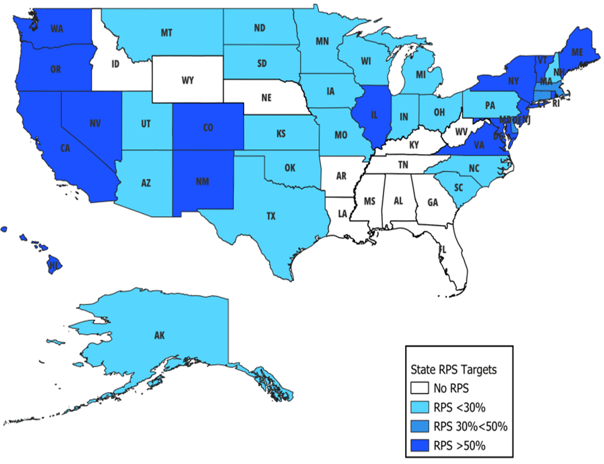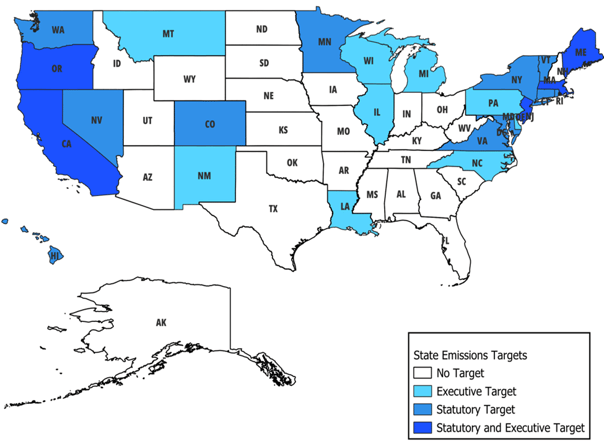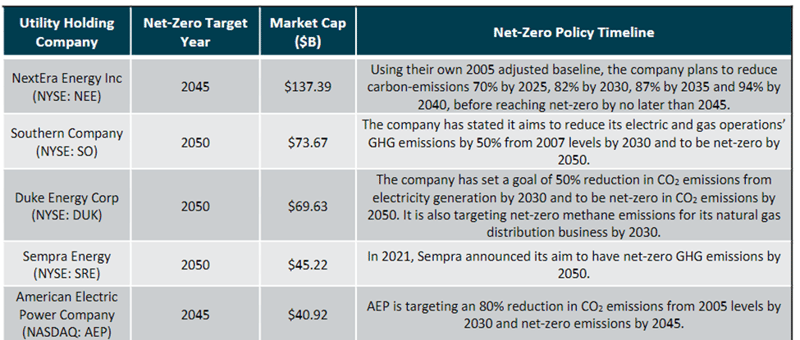
By John Foley | September 13, 2023
A Renewable Portfolio Standard (RPS) is a policy mechanism implemented at the state level that obliges utilities and electricity providers to acquire a certain percentage of their energy from renewable sources, such as wind, solar, hydro, geothermal, or biomass. In this Insight, we take a look at FactSet’s new U.S. Emissions and Renewable Portfolio Standards Report, which Workstation users can access here, to showcase the wide array of what states are doing to establish an RPS and set net-zero emissions targets.
What is an RPS’ purpose? How does it work?
The purpose of an RPS is to encourage the adoption of renewable energy technologies to reduce greenhouse gas (GHG) emissions and promote sustainability via long-term targets for the integration of renewable energy into the electricity generation mix.
Each state sets its own targets and timelines for increasing the share of renewable energy in its electricity mix. So, given that RPS policies are implemented at the state level, there is a diverse landscape of standards across the U.S.
Compliance with an RPS can be achieved through generating renewable energy or purchasing Renewable Energy Credits (RECs) from renewable energy producers. Given these variations, some states have targets as low as 1–2% and some that reach 100%. States with the highest RPS targets include California, Colorado, Illinois, Maine, New Mexico, New York, Rhode Island, Virginia, and Washington. The timelines set to achieve these targets also vary widely among states, from dates already past to as far out as 2050. And since high targets do not necessarily correlate with progress towards renewables adoption, much is dependent on a given state’s economic and natural resources.
Another interesting aspect of the RPS is that what qualifies as a “renewable” energy source can vary widely from state to state, as well. While wind and solar are commonly included, not all states consider hydroelectric, geothermal, or biomass in their list of renewable resources. A map of U.S. states and their respective RPS targets, or lack thereof, is visible below.
States with RPS Targets

Source: FactSet
While Renewable Portfolio Standards have contributed to the growth of renewable energy industries across the U.S., it does not appear to be the main driver of how quickly renewable energy sources are adopted. Much of the speed and intensity of a state’s adoption has to do with that state’s economic and natural resource position. Some states that have low-percentage RPS targets have achieved very high levels of adoption, and vice versa, due to the unique circumstances in those particular states.
States and Emission Standards
An emissions standard is another regulatory mechanism that sets limits on the release of pollutants or GHGs from emissions sources, such as vehicles, industrial facilities, or power plants. Policies can be set at the executive level by a governor or agency or by state legislatures. All emissions standards, however, can play an important role in environmental protection and sustainability efforts by promoting cleaner technologies and practices to improve air quality and mitigate the negative environmental impacts of human activity.
States with Emission Targets

Source: FactSet
States with both a statutory RPS and an emissions standard include California, Hawaii, Nevada, New York, Maine, Massachusetts, Vermont, and Virginia. States with neither a statutory RPS nor an emissions standard include Alabama, Alaska, Arkansas, Florida, Georgia, Idaho, Kentucky, Mississippi, Nebraska, Tennessee, West Virginia, and Wyoming.
States and Net-Zero
Some state emissions standards aim towards a goal of “net-zero” by a specified date in the future. Net-zero refers to the balance between the amount of GHGs emitted into the atmosphere and the amount removed to offset those emissions. In the context of climate change, achieving net-zero emissions means that the total emissions of GHGs, such as carbon dioxide, methane, or nitrous oxide, are equal to the total emissions removed from the atmosphere, either through natural processes, technological means, or carbon offsets.
State Net-Zero Targets

Source: FactSet
Federal Overlap?
Although a national RPS and other clean energy policies have been proposed, no federal RPS or similar policy is currently in place. There are federal regulations for GHG emissions, such as the 2015 Clean Power Plan (CPP) that was introduced to limit carbon dioxide emissions from power plants. The CPP faced legal challenges and was replaced by the Affordable Clean Energy (ACE) rule, which gave more flexibility to states in setting emissions standards.
The Biden administration has set a goal to achieve 100% clean electricity by 2035 and is considering federal RPS standards as a part of broader climate and clean energy legislation. There will undoubtedly be debate on the specific details of an RPS at the federal level, but if one was adopted, a federal RPS could provide consistent national standards and potentially motivate the transition to renewable energy on a larger scale.
In the absence of comprehensive federal policy, states have implemented their own GHG emissions standards and targets. Like RPS, they vary widely in terms of ambition and scope, with some states setting more stringent goals than others.
Considering the implementation of an RPS
Even if the purpose of an RPS or emission standard seems readily apparent, there are issues that help shape the pace and types of standards that are adopted. For example, cost and economics of adoption are two concerns that feed directly into the issue of a potential increase in electricity costs to consumers since transitioning from traditional fossil fuel sources to renewable energy requires significant investments in infrastructure and technology. For more information on utility affordability, see FactSet’s report here.
Two other concerns a state must consider are grid reliability and the process of integrating renewable energy sources into the existing electrical grid. The intermittency of certain renewable sources can pose challenges for grid stability and balancing supply and demand. Individual state infrastructures will vary in transmission networks, on-call generation capacity, renewable intermittency, and energy storage.
RPS implementation will likely require substantial infrastructure development, such as building new solar or wind farms and transmission lines or decommissioning high-emitting facilities. Before implementing an RPS or emissions standard, states also have to consider the availability of construction resources in the time specified to make the required changes or additions to infrastructure.
What are U.S. utilities doing?
While RPS policy decisions continue to evolve, many U.S. utilities have made voluntary commitments to achieve net-zero GHG emissions by 2050 or earlier. Utilities are achieving this through a variety of ways, primarily through the transition to renewable energy sources from fossil fuels. This shift is crucial in reducing emissions from the electricity sector, one of the largest sources of GHG emissions. All of the 20 largest publicly traded U.S. utility holding companies by market cap have current, albeit non-binding, policies in line with the United Nation’s Framework on Climate Change and the Paris Climate Agreement (net-zero by 2050). A brief summary of the company policies is shown below, with additional commentary found here.

Source: FactSet
Conclusion
All in all, renewable portfolio standards have become key policy mechanisms to promote renewable energy adoption in the utility industry. In the absence of federal legislation, states are developing their own RPS, emission standards, and net-zero polices the achievement of which will depend on their individual situations and economic trajectories. Each hurdle and concern, including cost, reliability, infrastructure development, opposition, and political support, must be addressed for successful implementation. States like California, New York, Hawaii, Maine, Vermont, Nevada, Virginia, and Massachusetts are leading the way with ambitious RPS targets, while the federal government is also considering implementing a federal RPS as part of its clean energy and climate change agenda. The full report, which includes individual state policies, what individual states are doing relative to their net-zero targets, and what other utilities are establishing as net-zero targets, is available to Workstation users here.
Tom Abrams contributed to this article.
This blog post is for informational purposes only. The information contained in this blog post is not legal, tax, or investment advice. FactSet does not endorse or recommend any investments and assumes no liability for any consequence relating directly or indirectly to any action or inaction taken based on the information contained in this article.

Entergy in a New Era of Data Center Driven Load Growth
Entergy is preparing for the growing wave of data center driven load growth through state-specific regulatory wins, customer...
By Leo Kelser | Energy

PJM Capacity Auction Preview: Will Prices Reach the Ceiling Again?
The pending results of the PJM Base Residual Auction for 2027/'28 have the market bracing for what appears to be a “new normal”...
By Eric Hinojosa | Energy

Class VI Primacy Update: Texas Moves Forward, Louisiana Pauses
While Texas begins the process of accepting and reviewing all Class VI permit applications, Louisiana has paused new Class VI...
By Jamison Braun | Energy

Solar Reshapes European Load, Favoring Storage
While overall electricity demand is falling in Europe, the surge in renewables is leading to attractive opportunities for energy...
By Matthew Hoza | Energy
The information contained in this article is not investment advice. FactSet does not endorse or recommend any investments and assumes no liability for any consequence relating directly or indirectly to any action or inaction taken based on the information contained in this article.